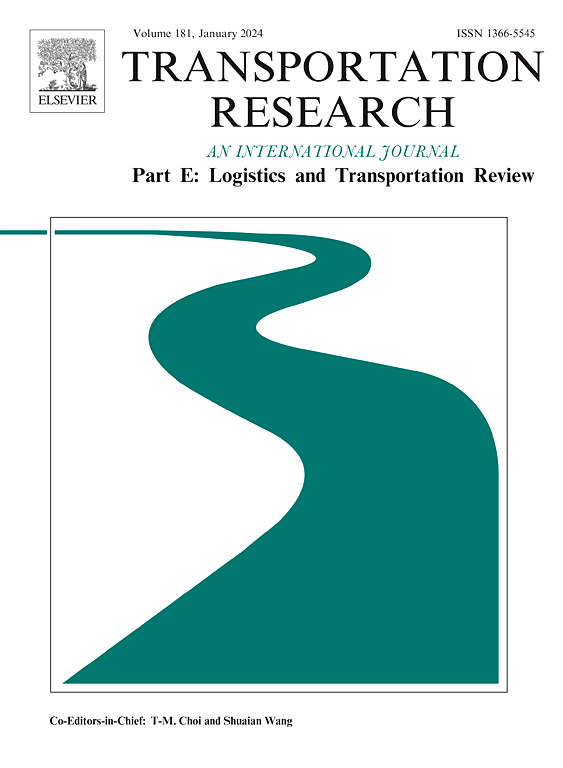Pricing and unauthorized channel strategies for a global manufacturer considering import taxes
IF 8.3
1区 工程技术
Q1 ECONOMICS
Transportation Research Part E-Logistics and Transportation Review
Pub Date : 2024-09-28
DOI:10.1016/j.tre.2024.103784
引用次数: 0
Abstract
Global manufacturers face a pricing dilemma: setting higher prices in foreign markets to offset import taxes may lead to unauthorized cross-border channels; while narrowing price differences between domestic and foreign markets to block these channels increases the tax burden. To address this challenge, we develop Stackelberg game models to investigate the pricing and unauthorized channel strategy for a global manufacturer. Our findings indicate that an unauthorized channel can benefit the manufacturer by providing a means to avoid import taxes and potentially increasing overall demand in the foreign market. When the impact of an unauthorized channel on brand reputation is low, the manufacturer should widen the price difference between domestic and foreign markets to allow it. Conversely, when facing high brand reputation risks, the manufacturer must consider the import tax in the foreign market. If the import tax is high, the manufacturer should narrow the price difference between domestic and foreign markets to block the unauthorized channel; otherwise, simply ignore the threat of the unauthorized channel and maintain regular prices. We also examine the effects of consumer acceptance of gray market products and import tax incentives for cross-border e-commerce. We find that an increase in the two factors enhances the manufacturer’s inclination to allow an unauthorized channel. Our results remain robust across varying import tax structures, production costs, consumer valuations, and exchange rates, as well as when there are differences in market potential and consumer valuation between domestic or foreign markets.
考虑到进口税,一家全球制造商的定价和非授权渠道战略
全球制造商面临着定价困境:在国外市场制定更高的价格以抵消进口税,可能会导致未经授权的跨境渠道;而缩小国内外市场的价格差异以阻断这些渠道,又会增加税收负担。为了应对这一挑战,我们建立了斯台克尔伯格博弈模型,以研究一家全球制造商的定价和非授权渠道策略。我们的研究结果表明,未经授权的渠道可以为制造商提供规避进口税的途径,并有可能增加国外市场的总体需求,从而使制造商受益。当非授权渠道对品牌声誉的影响较低时,制造商应扩大国内外市场的价格差异,允许非授权渠道的存在。相反,当面临较高的品牌声誉风险时,制造商必须考虑国外市场的进口税。如果进口税较高,制造商应缩小国内外市场的价格差异,以阻断非授权渠道;反之,则干脆无视非授权渠道的威胁,维持正常价格。我们还研究了消费者对灰色市场产品的接受程度和进口税优惠政策对跨境电子商务的影响。我们发现,这两个因素的增加会增强制造商允许非授权渠道的倾向。在进口税结构、生产成本、消费者价值和汇率不同的情况下,以及在国内或国外市场的市场潜力和消费者价值存在差异的情况下,我们的结果仍然是稳健的。
本文章由计算机程序翻译,如有差异,请以英文原文为准。
求助全文
约1分钟内获得全文
求助全文
来源期刊
CiteScore
16.20
自引率
16.00%
发文量
285
审稿时长
62 days
期刊介绍:
Transportation Research Part E: Logistics and Transportation Review is a reputable journal that publishes high-quality articles covering a wide range of topics in the field of logistics and transportation research. The journal welcomes submissions on various subjects, including transport economics, transport infrastructure and investment appraisal, evaluation of public policies related to transportation, empirical and analytical studies of logistics management practices and performance, logistics and operations models, and logistics and supply chain management.
Part E aims to provide informative and well-researched articles that contribute to the understanding and advancement of the field. The content of the journal is complementary to other prestigious journals in transportation research, such as Transportation Research Part A: Policy and Practice, Part B: Methodological, Part C: Emerging Technologies, Part D: Transport and Environment, and Part F: Traffic Psychology and Behaviour. Together, these journals form a comprehensive and cohesive reference for current research in transportation science.

 求助内容:
求助内容: 应助结果提醒方式:
应助结果提醒方式:


